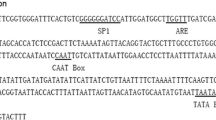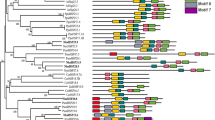Abstract
Heat shock protein 70s (Hsp70s) play particularly important roles in a variety of stress responses and have been widely studied in many higher plants and algae. Pyropia haitanensis blades inhabit the upper intertidal zones of rocky shores and are exposed to dynamic environmental changes associated with the turning tides, including desiccation and high-temperature stress. In this study, based on unigene sequences of P. haitanensis, five full-length PhHsp70 genes were obtained by rapid amplification of complementary DNA (cDNA) ends or direct PCR and named PhHsp70-1, PhHsp70-2, PhHsp70-3, PhHsp70-4, and PhHsp70-5. The full-length cDNA of the five PhHsp70 genes comprised 2,249, 2,380, 1,945, 2,177, and 2,327 nucleotides, respectively. The cDNAs encoded proteins of 664, 668, 621, 654, and 686 amino acids, with isoelectric points of 4.93, 5.17, 4.87, 5.09, and 5.04, respectively. On the basis of conserved motifs and phylogenetic tree analysis, the five PhHsp70s could be divided into four subfamilies, two in the cytoplasmic subfamily and one for each in the chloroplast, mitochondria, and endoplasmic reticulum subfamilies. The expressions of the five PhHsp70 genes, as measured by real-time quantitative PCR, were significantly induced by high-temperature stress but had different expression patterns under desiccation stress. These results suggested that PhHsp70s play important roles in the response to high-temperature stress but have no obvious functions in adaptation to desiccation stress, except under extreme desiccation conditions.




Similar content being viewed by others
References
Al-Whaibi MH (2011) Plant heat-shock proteins: a mini review. J King Saud Univ (Sci) 23:139–150
Blouin NA, Brodie JA, Grossman AC, Xu P, Brawley SH (2011) Porphyra: a marine crop shaped by stress. Trends Plant Sci 16:29–37
Chen CS, Ji DH, Xie CT, Xu Y, Liang Y, Zhen YJ, Shi XZ, Wang FX, Zhao LM (2008) Preliminary study on selecting the high temperature resistance strains and economic traits of Pyropia haitanensis. Acta Oceanol Sinica 30:100–106 (in Chinese with English abstract)
Daugaard M, Rohde M, Jäättelä M (2007) The heat shock protein 70 family: highly homologous proteins with overlapping and distinct functions. FEBS Lett 581:3702–3710
Downs CA, Mueller E, Phillips S, Fauth JE, Woodley CM (2000) A Molecular biomarker system for assessing the health of coral (Montastraea faveolata) during heat stress. Mar Biotech 2:533–544
Frydman J (2001) Folding of newly translated proteins in vivo: the role of molecular chaperones. Annu Rev Biochem 70:603–647
Fu WD, Yao JT, Wang XL, Liu FL, Fu G, Duan DL (2009) Molecular cloning and expression analysis of a cytosolic HSP70 gene from Laminara japonica (Laminariacease, Phaeophyta). Mar Biotech 11:738–747
Grover A, Mittal D, Negi M, Lavania D (2013) Generating high temperature tolerant transgenic plants: achievements and challenges. Plant Sci 205–206:38–47
Gupta SC, Sharma A, Mishra M, Mishra R, Chowdhuri DK (2010) Heat shock proteins in toxicology: how close and how far? Life Sci 86:377–384
Hamer B, Hamer DP, Müller WEG, Batel R (2004) Stress-70 proteins in marine mussel Mytilus galloprovincialis as biomarkers of environmental pollution: a field study. Environ Int 30:873–882
Hartl FU (1996) Molecular chaperones in cellular protein folding. Nature 381:571–579
Ireland HE, Harding SJ, Bonwick GA, Jones M, Smith CJ, Williams JHH (2004) Evaluation of heat shock protein 70 as a biomarker of environmental stress in Fucus serratus and Lemna minor. Biomarkers 9:139–155
Krebs RA, Feder ME (1998) Hsp70 and larval thermotolerance in Drosophila melanogaster: how much is enough and when is more too much? J. Insect Physiol 44:1091–1101
Lin BL, Wang JS, Liu HC, Chen RW, Meyer Y, Barakat A, Delseny M (2001) Genomic analysis of the Hsp70 superfamily in Arabidopsis thaliana. Cell Stress Chap 6:201–208
Liu W, Yang R, Xu LN, Zhang XL, Wang YJ, Sun X (2012) Cloning and expression of hsp70 for Porphyra haitanensis. J Ningbo Univ (NSEE) 25:17–25 (in Chinese with English abstract)
Ma JH, Xu P (2005) Genetics of marine red algae—Porphyra. In: Zhang XC, Qin S, Ma JH, Xu P (eds) The genetics of marine algae. China Agriculture Press, Beijing, p 184
Morris JP, Thatje S, Hauton C (2013) The use of stress-70 proteins in physiology: a re-appraisal. Molec Ecol 22:1494–1502
Munro S, Pelham HRB (1987) A C-terminal signal prevents secretion of luminal ER proteins. Cell 48:899–907
Park HS, Jeong WJ, Kim E, Jung Y, Lim JM, Hwang MS, Park EJ, Ha DS, Choi DW (2012) Heat shock protein gene family of the Porphyra seriata and enhancement of heat stress tolerance by PsHSP70 in Chlamydomonas. Mar Biotech 14:332–342
Renner T, Waters ER (2007) Comparative genomic analysis of the Hsp70s from five diverse photosynthetic eukaryotes. Cell Stress Chap 12:172–185
Sahoo D, Tang XR, Yarish C (2002) Porphyra-the economic seaweed as a new experimental system. Curr Sci 83:1313–1316
Schroda M, Vallon O (2009) Chaperones and proteases. In: Stern DB (ed) Chlamydomonas source book, 2nd edn. Elsevier, San Diego
Sørensen JG, Kristensen TN, Loeschcke V (2003) The evolutionary and ecological role of heat shock proteins. Ecol Lett 6:1025–1037
Sung DY, Kaplan F, Guy CL (2001a) Plant Hsp70 molecular chaperones: protein structure, gene family, expression and function. Physiol Plantarum 113:443–451
Sung DY, Vierling E, Guy CL (2001b) Comprehensive expression profile analysis of the Arabidopsis Hsp70 gene family. Plant Physiol 126:789–800
Sutherland J, Lindstrom S, Nelson W, Brodie J, Lynch M, Hwang M, Choi H, Miyata M, Kikuchi N, Oliveira MC, Farr T, Neefus C, Mols-Mortensen A, Milstein J, Miller K (2011) A new look at an ancient order: generic revision of the Bangiales. J Phycol 47:1131–1151
Tamura K, Peterson D, Peterson N, Stecher G, Nei M, Kumar S (2011) MEGA5: molecular evolutionary genetics analysis using maximum likelihood, evolutionary distance, and maximum parsimony methods. Mol Biol Evol 28:2731–2739
Thompson JD, Gibson TJ, Plewniak F, Jeanmougin F, Higgins DG (1997) The Clustal X windows interface: flexible strategies for multiple sequence alignment aided by quality analysis tools. Nucl Acids Res 25:4876–4882
Torres MA, Barros MP, Campos SC, Pinto E, Rajamani S, Sayre RT, Colepicolo P (2008) Biochemical biomarkers in algae and marine pollution: a review. Ecotoxicol Environ Saf 71:1–15
Wang W, Vinocur B, Shoseyov O, Altman A (2004) Role of plant heat-shock proteins and molecular chaperons in the abiotic stress response. Trends Plant Sci 9:244–252
Xie CT, Li B, Xu Y, Ji DH, Chen CS (2013) Characterization of the global transcriptome for Pyropia haitanensis (Bangiales, Rhodophyta) and development of cSSR markers. BMC Genomics 14:107
Xu Y, Chen CS, Ji DH, Hang N, Xie CT (2014) Proteomic profile analysis of Pyropia haitanensis in response to high-temperature stress. J Appl Phycol 26:607–618
Yan XH, Lv F, Liu CJ, Zheng YF (2010) Selection and characterization of a high-temperature tolerant strain of Porphyra haitanensis Chang et Zheng (Bangiales, Rhodophyta). J Appl Phycol 22:511–516
Zhou XH, Li XS, Wang P, Yan BL, Yi LF, Teng YJ (2011) Expression profiles of HSP70 gene in gametophytic blade of laver Porphyra yezoensis Ueda by high temperature stress. Fish Sci 30:233–237 (in Chinese with English abstract)
Acknowledgments
This research was supported in part by the 863 Project of China (grant no. 2012AA10A411), the National Natural Science Foundation of China (grant nos. 41176151 and 41276177), and the National Marine Public Welfare Research Project (grant nos. 201105008 and 201105023).
Author information
Authors and Affiliations
Corresponding author
Rights and permissions
About this article
Cite this article
Ji, D., Li, B., Xu, Y. et al. Cloning and quantitative analysis of five heat shock protein 70 genes from Pyropia haitanensis . J Appl Phycol 27, 499–509 (2015). https://doi.org/10.1007/s10811-014-0314-6
Received:
Revised:
Accepted:
Published:
Issue Date:
DOI: https://doi.org/10.1007/s10811-014-0314-6




